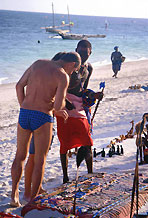The Samburu age system divides all the men of the society into three age-grades, "boyhood (from birth to initiation)", "moran-hood (from initiation to marriage)", and "elderhood (after marriage)." I focus mainly on the "moran," who are initiated, and in the status of prolonged adolescence, because their marriage is socially postponed. Body adornments indicate a person's social or ritual status, and the transfer of adornments establishes social relationship between the giver and the recipient. In particular, the moran wear many beaded adornments, and in recent years these adornments have become increasingly flamboyant and eye-catching. This study examines changes in the adornments in relation to the new experiences of the moran under such modern conditions as school enrollment, migrant work, tourism, and the market economy and analyzes what changes they have effected in the age system. (3) Many Samburu moran go to work as migrants in Mombasa, a coastal tourist resort area located 800 km from Samburu. There they perform "traditional" dances and sell beaded adornments to tourists. On this trip, I carried out field research in order to: (1) grasp the overall conditions of this migrant labor, and (2) gather data for the comparative study of adornments of the moran in Samburu and Mombasa (I had already accumulated data from Samburu during my 20 months of field research since 1999). The research period was from 15 December 2002 to 28 February 2003. For the first few weeks I did supplementary research in Samburu and then went to Mombasa. The findings of my research are as follows: 1. Outline of migrant labor in Mombasa: I clarified the history of Samburu migrant labor in Mombasa (late 1960's-present), types of employment (night watchmen, dancing, selling beaded adornments), the number of people in each category of work, forms of contract, payment, and existence of mutual aid associations.I will discuss how these experiences of the moran, as they interact with and sell their adornments to foreign tourists, relate to the social changes in Samburu society, especially the age systems, and their ethnic or moran-hood identities. |


 21st Century COE Program
-Aiming for COE of Integrated Area Studies-
21st Century COE Program
-Aiming for COE of Integrated Area Studies-